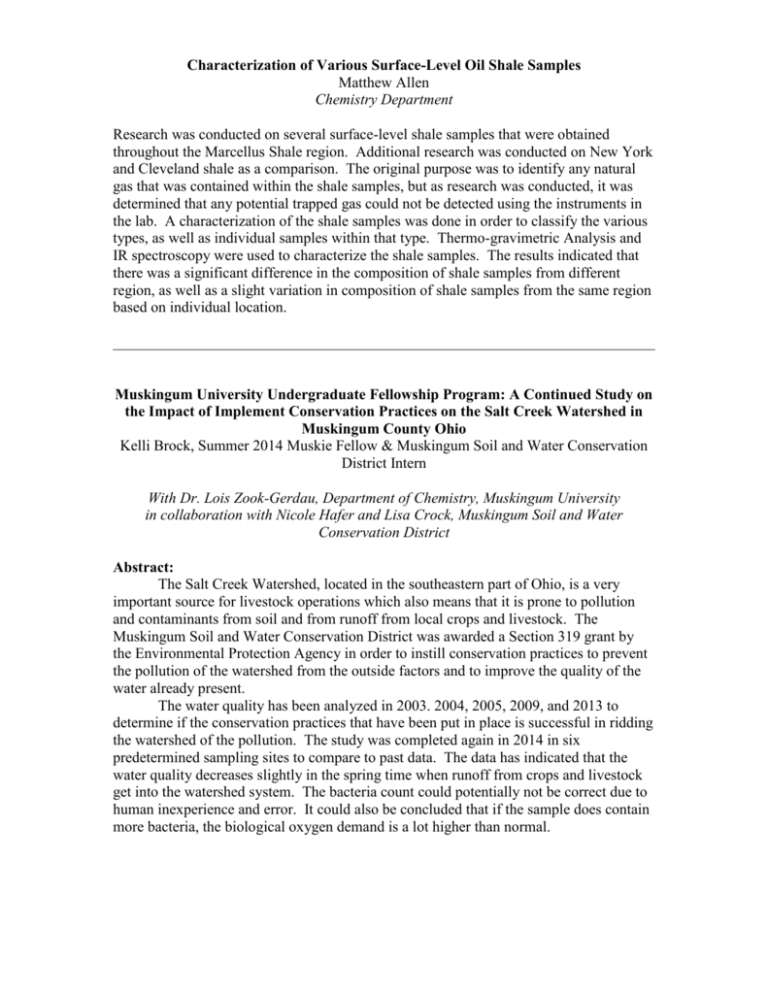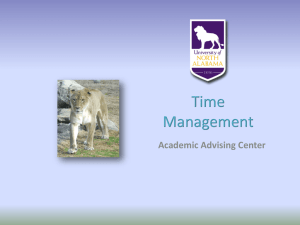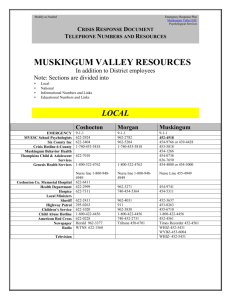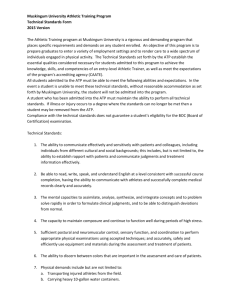2014AbstractCompilation
advertisement

Characterization of Various Surface-Level Oil Shale Samples Matthew Allen Chemistry Department Research was conducted on several surface-level shale samples that were obtained throughout the Marcellus Shale region. Additional research was conducted on New York and Cleveland shale as a comparison. The original purpose was to identify any natural gas that was contained within the shale samples, but as research was conducted, it was determined that any potential trapped gas could not be detected using the instruments in the lab. A characterization of the shale samples was done in order to classify the various types, as well as individual samples within that type. Thermo-gravimetric Analysis and IR spectroscopy were used to characterize the shale samples. The results indicated that there was a significant difference in the composition of shale samples from different region, as well as a slight variation in composition of shale samples from the same region based on individual location. ________________________________________________________________________ Muskingum University Undergraduate Fellowship Program: A Continued Study on the Impact of Implement Conservation Practices on the Salt Creek Watershed in Muskingum County Ohio Kelli Brock, Summer 2014 Muskie Fellow & Muskingum Soil and Water Conservation District Intern With Dr. Lois Zook-Gerdau, Department of Chemistry, Muskingum University in collaboration with Nicole Hafer and Lisa Crock, Muskingum Soil and Water Conservation District Abstract: The Salt Creek Watershed, located in the southeastern part of Ohio, is a very important source for livestock operations which also means that it is prone to pollution and contaminants from soil and from runoff from local crops and livestock. The Muskingum Soil and Water Conservation District was awarded a Section 319 grant by the Environmental Protection Agency in order to instill conservation practices to prevent the pollution of the watershed from the outside factors and to improve the quality of the water already present. The water quality has been analyzed in 2003. 2004, 2005, 2009, and 2013 to determine if the conservation practices that have been put in place is successful in ridding the watershed of the pollution. The study was completed again in 2014 in six predetermined sampling sites to compare to past data. The data has indicated that the water quality decreases slightly in the spring time when runoff from crops and livestock get into the watershed system. The bacteria count could potentially not be correct due to human inexperience and error. It could also be concluded that if the sample does contain more bacteria, the biological oxygen demand is a lot higher than normal. Artificial Intelligence Capable of Deducing Hidden Elements in Gaming Structures Nicholas Bulinski Department of Mathematics and Computer Science The goal of this fellowship was to create an artificial intelligence (AI) that can deduce a hidden variable in a gaming structure and use it to win some a game. In order to do this a board game was needed for the AI to play in which deducing hidden elements were key to winning the game. The game used in this study is called The Resistance. In The Resistance players can be one of two teams, either they are part of the resistance trying to overthrow an evil government, or they are on the spy team that is trying to stop the resistance. The game is comprised of five missions. If three of them succeed the resistance wins but if three missions fail the spies will win. In order to fulfill the project requirements the AIs created for the game would act as resistance players. The hidden element that the AIs would be trying to deduce would be whether a player was a spy or a resistance member. The project started with research into what artificial intelligence techniques are used for game AI. Expert systems, heuristics, finite state space machines, and artificial neural networks are just a few examples of the kinds of AI that can be used in gaming. Do to this abundance of AI techniques the project had to focus on only two in particular, expert systems and artificial neural networks. Expert systems are AIs that make decisions based off of if-then rules that are provided by human “experts”. The other method pursued was artificial neural networks (ANN or neural net). ANNs are composed of nodes or neurons and weighted links between each node. These links and nodes are then organized into the network layers that make up the neural network. The neural net then learns by strengthening or weakening the links between the nodes. Evaluating the effectiveness of AIs would be done by having them play as resistance members and seeing how many games they win. ________________________________________________________________________ PRESENCE OF CBL IN NEURONS AND ASTROCYTES Aliyah Byron1, Kaitlyn Hassenfeild2, Erica Carey2 Robert E. McCullumsmith2, Jenifer McGuire2 1 Muskingum University Neuroscience Program 2 University of Cincinnati, Department of Psychiatry and Behavioral Neuroscience To understand cognitive disorders, we looked at the molecular differences in neurons and astrocytes. Specifically, the project looked at the difference in CBL expression between pyramidal neurons and astrocytes. Fresh frozen slides of human brain tissue were stained using Rapid Nissl Staining Technique. Neurons and astrocytes were cut using Laser Capture Microdissection and the amount of CBL and other genes was tested with real time Polymerase Chain Reaction. No significant difference in CBL expression between neurons and astroycyte was found. GAD1 was expressed more in neurons than in astrocytes. These findings may be explained by an interneuron contamination in our astrocyte population. In future studies, we will refine our definition of astrocytes in an attempt to reduce the contamination of interneurons. Methods for Grafting Short Polymeric Units onto Kraft lignin Deborah N. Carrol, Cameron J. Godfrey Department of Chemistry The synthesis and structural analysis of co-polymers of Kraft lignin that may be used as the basis for the synthesis of biodegradable polymers will be discussed. The methodology makes use of lignin, a natural product produced from wood pulping, as the major organic source for this polymeric synthetic approach. The approach is generally applicable and can be easily modified to make use of a wide variety of monomers for crosslinking the lignin. Fluorometry was used to determine the coupling efficiency of adding naphthyl boronic acid to the lignin via a Suzuki coupling reaction. The coupled naphthalene then served as a readily available site for the addition of polymeric linkers through zinccatalyzed Friedel-Crafts acylation using 4-pentenoyl chloride. Different ratios of styrene, divinyl benzene and 2-hydroxyethyl acrylate were then used for atom transfer radical polymerization (ATRP) of the modified lignin, using 2,2’-azobis (2methylpropionitrile)(AIBN) as free the radical initiator. Fourier transform infrared spectroscopy (FT-IR), solubility and thermogravimetric analysis (TGA) was used to characterize the resultant co-polymers. ________________________________________________________________________ SURVEY OF AMPHIBIAN DISTRIBUTION ON A 26-HECTARE PLOT SURROUNDED BY RECLAIMED SURFACE MINE LAND Hayley Glaze, Bowen Deng and Dr. Danny Ingold Environmental Science Program North American amphibian populations have been declining during the past 25 years. Amphibians are particularly vulnerable to soil and water pollution and thus serve as good indicators of environmental health. Their decline in the Appalachian Region of the eastern U.S. is likely linked, at least in part, to fossil fuel extraction which has contributed to habitat alteration and water pollution. This study was conducted from late May through July 2014 and during September 2014 in Muskingum Co., Ohio. The objective was to survey the amphibians (calls, minnow traps and ground searches) on an abandoned 26-ha farm surrounded on three sides by reclaimed mined land and compare the salamander diversity of this site with that of a forested stream site on the Muskingum University campus. A total of seven anuran species were identified by their calls on the farm (vernal pools, small pond, and marsh area). The most common species (chorus size and frequency of detection) were spring peepers (Pseudacris crucifer) and green frogs (Rana clamitans). Red-spotted newts (Notophthalmus viridescens) were the only salamander species captured in minnow traps (n = 5), while northern ravine salamanders (Plethodon electromorphus) were the most prevalent land species (n = 9). Although the water quality on this site was generally good (pH, dissolved O2, nitrates etc.), salamander species diversity and abundance was lower than on the Muskingum campus site. These findings suggest that extensive surface mining and subsequent land reclamation, leaving patches of island forests behind, might adversely affect salamander abundance and diversity. An Internship at Fern Hollow Nature Center Sarah E. Francino Biology Department Over the summer I had an internship at Fern Hollow Nature Center. Fern Hollow is a nature center in Pittsburgh Pennsylvania. I found this internship by looking at the nature centers close to my house. During this internship I managed the gardens, worked with kids, helped run large events, and performed animal care. I would recommend that anyone looking to go into science education do an internship like this one. Many other types of majors would benefit from an experience like this one. ________________________________________________________________________ A comparison of grassland bird point-count data on two regions of a reclaimed surface mine (the Wilds) in southeastern Ohio Jennifer Hastings, Biology Department, Muskingum University (hastings@muskingum.edu) Connor Hann, Biology Dept., Muskingum University Allie Leggett, Biology Dept., Muskingum University Sarah Landuyt, Biology Dept., Muskingum University Morgenna Zuby, Biology Dept., Muskingum University Jonathan Raugh, Biology Dept., Muskingum University Devin Perry, Biology Dept., Muskingum University Abstract: Although reclaimed surface mines provide suitable nesting habitat for several obligate grassland bird species, there have been management concerns in recent years regarding changes in plant species composition and the encroachment of woody vegetation on such mines. During May-July 2014 we conducted pointcount surveys of grassland birds on two areas of a former surface mine that were reclaimed during different time periods (Zion Ridge – ZR – 1950s through early 1970s and southern sector – SS – early 1980s). Our goal was to look for differences in the abundance of several grassland bird species on the two sites and to make a broad comparison in the plant species composition between the areas. Counts at 23 point sites on the SS revealed significantly more Henslow’s Sparrows (Ammodramus henslowii) in June and July compared to 17 sites on ZR during the same months (t = 2.07, df = 38, p < 0.04, June; t = 3.23, df = 38, p < 0.002, July). Significantly more Bobolinks (Dolichonyx oryzivorus) were detected in May, during the peak of their breeding, on the SS (t = 3.15, df = 38, p < 0.003) versus ZR. Conversely significantly more Grasshopper Sparrows (A. savannarum) were detected in May and June on ZR versus the SS region (t = 5.73, df = 38, p < 0.0001, May; t = 5.47, df = 38, p < 0.0001, June). Short grasses that produce less ground cover such as fescue (Festuca sp.), and smooth brome (Bromus inermis) were more prominent on the ZR region, while thicker grasses and herbs such as blue grass (Poa pratensis) and bird’s foot trefoil (Lotus corniculatus) were more abundant in the SS area. In addition the SS area had a greater prevalence of taller herbaceous forbs including goldenrod (Solidago sp.), teasel (Dipsacus sylvestris), queen anne’s lace (Daucus carota) and others. These vegetative differences in the two regions associated with different reclamation and restoration efforts likely help to explain differences in grassland bird species diversity between the two regions. Rural Action Internship at Huff Run Watershed Sarah Homan Geology Department Huff Run watershed is a restoration partnership devoted to cleaning up pollution caused by bad mining practices. Huff Run is lead Rural Action, a non-profit organization devoted to revitalizing Appalachia. Rural Action works with Americorps, a national service organization, to fuel their programs. The programs include a zero waste initiative, an environmental education program, Ohio Stream Restore Corp. and a sustainable agriculture program. There are seven watershed affiliated with Rural Action, Huff Run being the smallest. The internship involved: chemical and biological water quality sampling both in conjunction with ODNR, community outreach, and a week long day camp geared towards the environmental education of children between the ages of eight and twelve. Huff Run is located in Mineral City, Ohio. This area was heavily mined for coal but nothing was cleaned up, if it wasn’t used it was just left on the ground. Now, rain water runs off of the left over gob piles and groundwater runs through the abandoned mines, leaching out toxic chemicals and metals. The Watershed employs multiple methods of restoration to reclaim the land but faces complications because of the small size of its streams. ________________________________________________________________________ Internship at the Williamstown Animal Hospital, WV Rebecca Keeley Biology Department at Muskingum University When shadowing a small animal veterinarian, one can acquire knowledge of the different procedures that takes place in an office. After taking care of the boarders, surgeries are scheduled to take place. These include spays/neuters, declawing, dentals, third eye lid flap, cruciate surgery, hematoma repair, exploratory, jaw reconstruction, limb amputation, bladder stone removal, growth removal, and many more. Along with various surgeries, the veterinarian must interact with patients and their owners. Some common problems seen in a veterinarian office is intervertebral disc disease, collapsing trachea, and anal sac abscesses. Microscope work is a daily occurrence, observing stool samples for parasites and ear mites, as well as examining urine and blood samples. Also, euthanasia, suture removal, sub-Q fluids, cystocentesis, drawing blood, vaccinations, dispensing medication, enemas, laser treatment, expressing anal glands, and taking x-rays are very common in the veterinarian practice. Observing all of these procedures give students an insight to what a small animal veterinarian does every day. CONTIONUS IMPROVEMENT OF FACTORY PREFORMANCE AND RELIABILITY Sean Lally Department of Physics & Engineering Improving a factory’s manufacturing efficiency allows a company to outperform its competitors and increase profitability. The standardization of changeover procedures and maintenance inspections improves the performance and reliability of the entire operation. The restructuring of changeover procedures and maintenance inspections was conducted on several assembly lines at a Colgate-Palmolive plant in Cambridge, Ohio. The production process and existing operating procedures were analyzed to identify areas of improvement. Creating a new standard for operations and restructuring the machine’s tools and instruments improved efficiency and reliability of the manufacturing process. ________________________________________________________________________ Butterfly Diversity of Butterfly Habitats at The Wilds Cumberland, Ohio Alexandra Leggett Conservation Science Program Recent studies have indicated that butterfly populations have been on the decline across the globe. The Wilds, located in Cumberland, Ohio, created a butterfly habitat in the spring of 2003 on ten acres of land with aim of restoring butterfly populations on their property. For this study, data on butterfly diversity and relative abundance were collected in August and September of 2014. Ten circular gardens were surveyed once a week and results were recorded on a data sheet displaying 29 butterfly species common to the area. Results from these surveys indicated that Eastern Tailed Blue (Cupido comyntas), Cabbage White (Pieris brassicae), Clouded Sulphur (Colias philodice), Orange Sulphur (Colias eurytheme), and Viceroy (Limenitis archippus) were the most common species in the habitat. Diversity was lower than has been observed in the past. It may be that declining plant diversity is responsible for what appears to be a decline in butterfly diversity. Occupational Therapy Observation Hours at Aultman and Concorde Kids Taylor Maurer Biology Department, Muskingum University Occupational Therapy is a form of therapy that helps people with physical or mental illnesses. To acquire success in treatments, the therapists perform activities on the patients that are required in daily life. Most Occupational therapy graduate schools would like around 30-40 hours of observation and to see a variety of settings in those hours so they know you are diverse in your work ethic. It is also highly recommended to have one internship experience during your undergrad. These internships were obtained by calling the places and setting up appointments to meet with them and having them sign a paper through Muskingum University to show proof I will be interning with them this summer. The internships were at two different locations and had two different focuses. Aultman is a therapy facility where the focus is on all ages from 10 years old to 100 years old and dealt mainly with upper extremity injuries. Concorde Kids was a facility in Canton, Ohio where the focus is strictly on kids from 1- 18 years of age. Concorde Kids would deal with kids who had psychological development issues, mental issues, ADHD, postural problems, sensory integration issues, fine motor and motor development issues. For both internships it was three to four days a week and accumulated a little over 100 hours of experience this past summer. ________________________________________________________________________ Thermodynamic Investigation of Marcellus Shale Richard Moore Chemistry Department Marcellus shale was investigated using basic thermodynamic techniques in an attempt to examine natural gas in shale. Three samples of different maturity shale from New York, Cleveland, and Virginia were analyzed using bomb calorimetry and DSC. These samples were also tested after being treated with 1M HCl as an attempt to remove carbonates from the rock to expose the organic material housing the natural gas. The DSC results agreed with literature results that the heating of shale samples was an exothermic process. The heat content from the bomb calorimetry was found to range from 13.91 cal/g to 395.21 cal/g. The sulfur and nitrogen contents were also determined from bomb calorimetry. The sulfur percentage ranged from 1.22% to 2.14%. The nitrogen content in the samples ranged from .09% to .14%. Acid treatment slightly impacted the heat content values and sulfur percentage.






